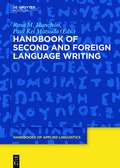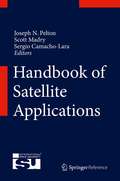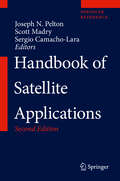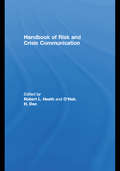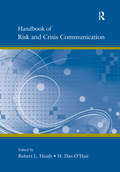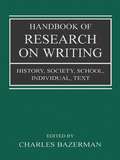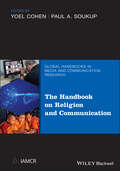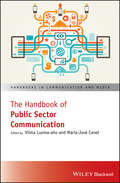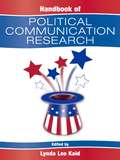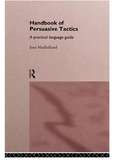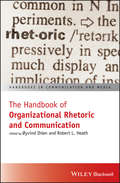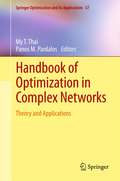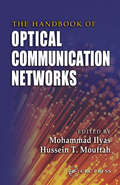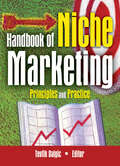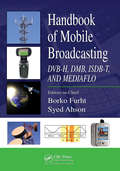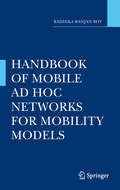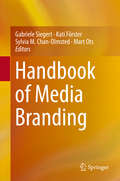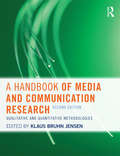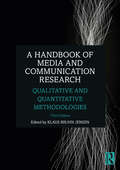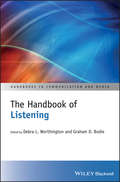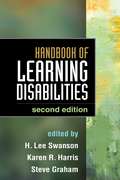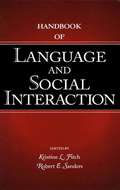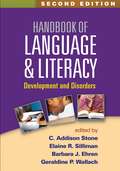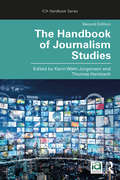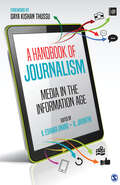- Table View
- List View
Handbook of Second and Foreign Language Writing (Handbooks Of Applied Linguistics #11)
by Rosa M. Manchón Paul Kei MatsudaThe Handbook of Second and Foreign Language Writing is an authoritative reference compendium of the theory and research on second and foreign language writing that can be of value to researchers, professionals, and graduate students. It is intended both as a retrospective critical reflection that can situate research on L2 writing in its historical context and provide a state of the art view of past achievements, and as a prospective critical analysis of what lies ahead in terms of theory, research, and applications. Accordingly, the Handbook aims to provide (i) foundational information on the emergence and subsequent evolution of the field, (ii) state-of-the-art surveys of available theoretical and research (basic and applied) insights, (iii) overviews of research methods in L2 writing research, (iv) critical reflections on future developments, and (iv) explorations of existing and emerging disciplinary interfaces with other fields of inquiry.
Handbook of Satellite Applications
by Sergio Camacho-Lara Scott Madry Joseph N. PeltonTop space experts from around the world have collaborated to produce this comprehensive, authoritative, and clearly illustrated reference guide to the fast growing, multi-billion dollar field of satellite applications and space communications. This handbook, done under the auspices of the International Space University based in France, addresses not only system technologies but also examines market dynamics, technical standards and regulatory constraints. The handbook is a completely multi-disciplinary reference book that covers, in an in-depth fashion, the fields of satellite telecommunications, Earth observation, remote sensing, satellite navigation, geographical information systems, and geosynchronous meteorological systems. It covers current practices and designs as well as advanced concepts and future systems. It provides a comparative analysis of the common technologies and design elements for satellite application bus structures, thermal controls, power systems, stabilization techniques, telemetry, command and control (TTC), and orbital configurations. These common aspects are addressed in an integrated fashion to explain how all these space systems share similar design features, but also have quite specialized application packages to carry out their various missions. No other reference in print today provides such a comprehensive and in-depth guide to all forms of application satellites, including small sats as used by countries just beginning space application programs.
Handbook of Satellite Applications
by Joseph N. Pelton Scott Madry Sergio Camacho-LaraTop space experts from around the world have collaborated to produce this comprehensive, authoritative, and clearly illustrated reference guide to the fast growing, multi-billion dollar field of satellite applications and space communications. This handbook, done under the auspices of the International Space University based in France, addresses not only system technologies but also examines market dynamics, technical standards and regulatory constraints. The handbook is a completely multi-disciplinary reference book that covers, in an in-depth fashion, the fields of satellite telecommunications, Earth observation, remote sensing, satellite navigation, geographical information systems, and geosynchronous meteorological systems. It covers current practices and designs as well as advanced concepts and future systems. It provides a comparative analysis of the common technologies and design elements for satellite application bus structures, thermal controls, power systems, stabilization techniques, telemetry, command and control (TTC), and orbital configurations. These common aspects are addressed in an integrated fashion to explain how all these space systems share similar design features, but also have quite specialized application packages to carry out their various missions. No other reference in print today provides such a comprehensive and in-depth guide to all forms of application satellites, including small sats as used by countries just beginning space application programs.
Handbook of Risk and Crisis Communication (Routledge Communication Ser.)
by H. Dan O'Hair Robert L. HeathThe Handbook of Risk and Crisis Communication explores the scope and purpose of risk, and its counterpart, crisis, to facilitate the understanding of these issues from conceptual and strategic perspectives. Recognizing that risk is a central feature of our daily lives, found in relationships, organizations, governments, the environment, and a wide variety of interactions, contributors to this volume explore such questions as: "What is likely to happen, to whom, and with what consequences?"; "To what extent can science and vigilance prevent or mitigate negative outcomes?"; and "What obligation do some segments of local, national, and global populations have to help other segments manage risks?", shedding light on the issues in the quest for definitive answers. The Handbook offers a broad approach to the study of risk and crisis as joint concerns. Chapters explore the reach of crisis and risk communication, define and examine key constructs, and parse the contexts of these vital areas. As a whole, the volume presents a comprehensive array of studies that highlight the standard principles and theories on both topics, serving as the largest effort to date focused on engaging risk communication discussions in a comprehensive manner. With perspectives from psychology, sociology, anthropology, political science, economics, and communication, the Handbook of Risk and Crisis Communication enlarges the approach to defining and recognizing risk and how should it best be managed. It provides vital insights for all disciplines studying risk, including communication, public relations, business, and psychology, and will be required reading for scholars and researchers investigating risk and crisis in various contexts.
Handbook of Risk and Crisis Communication (Routledge Communication Series)
by Robert L. Heath; H. Dan O’HairThe Handbook of Risk and Crisis Communication explores the scope and purpose of risk, and its counterpart, crisis, to facilitate the understanding of these issues from conceptual and strategic perspectives. Recognizing that risk is a central feature of our daily lives, found in relationships, organizations, governments, the environment, and a wide variety of interactions, contributors to this volume explore such questions as "What is likely to happen, to whom, and with what consequences?" "To what extent can science and vigilance prevent or mitigate negative outcomes?" and "What obligation do some segments of local, national, and global populations have to help other segments manage risks?", shedding light on the issues in the quest for definitive answers.The Handbook offers a broad approach to the study of risk and crisis as joint concerns. Chapters explore the reach of crisis and risk communication, define and examine key constructs, and parse the contexts of these vital areas. As a whole, the volume presents a comprehensive array of studies that highlight the standard principles and theories on both topics, serving as the largest effort to date focused on engaging risk communication discussions in a comprehensive manner. Now available in paperback, the Handbook of Risk and Crisis Communication can be readily used in graduate coursework and individual research programs. With perspectives from psychology, sociology, anthropology, political science, economics, and communication, the Handbook provides vital insights for all disciplines studying risk, and is required reading for scholars and researchers investigating risk and crisis in various contexts.
Handbook of Research on Writing: History, Society, School, Individual, Text
by Charles BazermanThe Handbook of Research on Writing ventures to sum up inquiry over the last few decades on what we know about writing and the many ways we know it: How do people write? How do they learn to write and develop as writers? Under what conditions and for what purposes do people write? What resources and technologies do we use to write? How did our current forms and practices of writing emerge within social history? What impacts has writing had on society and the individual? What does it mean to be and to learn to be an active participant in contemporary systems of meaning? This cornerstone volume advances the field by aggregating the broad-ranging, interdisciplinary, multidimensional strands of writing research and bringing them together into a common intellectual space. Endeavoring to synthesize what has been learned about writing in all nations in recent decades, it reflects a wide scope of international research activity, with attention to writing at all levels of schooling and in all life situations. Chapter authors, all eminent researchers, come from disciplines as diverse as anthropology, archeology, typography, communication studies, linguistics, journalism, sociology, rhetoric, composition, law, medicine, education, history, and literacy studies. The Handbook’s 37 chapters are organized in five sections:*The History of Writing;*Writing in Society;*Writing in Schooling;*Writing and the Individual; *Writing as Text This volume, in summing up what is known about writing, deepens our experience and appreciation of writing—in ways that will make teachers better at teaching writing and all of its readers better as individual writers. It will be interesting and useful to scholars and researchers of writing, to anyone who teaches writing in any context at any level, and to all those who are just curious about writing.
The Handbook of Religion and Communication (Global Handbooks in Media and Communication Research)
by Yoel Cohen Paul A. SoukupProvides a contemporary view of the intertwined relationship of communication and religion The Handbook on Religion and Communication presents a detailed investigation of the complex interaction between media and religion, offering diverse perspectives on how both traditional and new media sources continue to impact religious belief and practice across multiple faiths around the globe. Contributions from leading international scholars address key themes such as the changing role of religious authority in the digital age, the role of media in cultural shifts away from religious institutions, and the ways modern technologies have transformed how religion is communicated and portrayed. Divided into five parts, the Handbook opens with a state-of-the-art overview of the subject’s intellectual landscape, introducing the historical background, theoretical foundations, and major academic approaches to communication, media, and religion. Subsequent sections focus on institutional and functional perspectives, theological and cultural approaches, and new approaches in digital technologies. The essays provide insight into a wide range of topics, including religious use of media, religious identity, audience gratification, religious broadcasting, religious content in entertainment, films and religion, news reporting about religion, race and gender, the sex-religion matrix, religious crisis communication, public relations and advertising, televangelism, pastoral ministry, death and the media, online religion, future directions in religious communication, and more. Explores the increasing role of media in creating religious identity and communicating religious experience Discusses the development and evolution of the communication practices of various religious bodies Covers all major media sources including radio, television, film, press, digital online content, and social media platforms Presents key empirical research, real-world case studies, and illustrative examples throughout Encompasses a variety of perspectives, including individual and institutional actors, academic and theoretical areas, and different forms of communication media Explores media and religion in Judeo-Christian traditions, Islam, Buddhism, Hinduism, religions of Africa, Atheism, and others The Handbook on Religion and Communication is an essential resource for scholars, academic researchers, practical theologians, seminarians, mass communication researchers, and undergraduate and graduate students taking courses on media and religion.
The Handbook of Public Sector Communication (Handbooks in Communication and Media #91)
by Vilma Luoma-Aho María‐José CanelA multidisciplinary collection on global public entity strategic communication Research into public sector communication investigates the interaction between public and governmental entities and citizens within their sphere of influence. Today’s public sector organizations are operating in environments where people receive their information from multiple sources. Although modern research demonstrates the immense impact public entities have on democracy and societal welfare, communication in this context is often overlooked. Public sector organizations need to develop “communicative intelligence” in balancing their institutional agendas and aims of public engagement. The Handbook of Public Sector Communication is the first comprehensive volume to explore the field. This timely, innovative volume examines the societal role, environment, goals, practices, and development of public sector strategic communication. International in scope, this handbook describes and analyzes the contexts, policies, issues, and questions that shape public sector communication. An interdisciplinary team of leading experts discusses diverse subjects of rising importance to public sector, government, and political communication. Topics include social exchange relationships, crisis communication, citizen expectations, measuring and evaluating media, diversity and inclusion, and more. Providing current research and global perspectives, this important resource: Addresses the questions public sector communicators face today Summarizes the current state of public sector communication worldwide Clarifies contemporary trends and practices including mediatization, citizen engagement, and change and expectation management Addresses global challenges and crises such as corruption and bureaucratic roadblocks Provides a framework for measuring communication effectiveness Requiring minimal prior knowledge of the field, The Handbook of Public Sector Communication is a valuable tool for academics, students, and practitioners in areas of public administration, public management, political communication, strategic and organizational communication, and related fields such as political science, sociology, marketing, journalism, and globalization studies.
Handbook of Political Communication Research (Routledge Communication Series)
by Lynda Lee KaidThe Handbook of Political Communication Research is a benchmark volume, defining the most important and significant thrusts of contemporary research and theory in political communication. Editor Lynda Lee Kaid brings together exemplary scholars to explore the current state of political communication research in each of its various facets. Reflecting the interdisciplinary nature of political communication scholarship, contributions represent research coming from communication, political science, journalism, and marketing disciplines, among others. The Handbook demonstrates the broad scope of the political communication discipline and emphasizes theoretical overviews and research synthesis, with each chapter providing discussion of the major lines of research, theory, and findings for the area of concern. Chapters are organized into sections covering: *The theoretical background, history, structure, and diversity of political communication; *Messages predominant in the study of political communication, ranging from classical rhetorical modes to political advertising and debates; *News media coverage of politics, political issues, and political institutions; *Public opinion and the audiences of political communication;*European and Asian perspectives on political communication; and*Trends in political communication study, including the Internet, and its role in changing the face of political communication. As a comprehensive and thorough examination of the political communication discipline--the first in over two decades--this Handbook is a "must-have" resource for scholars and researchers in political communication, mass communication, and political science. It will also serve readers in public opinion, political psychology, and related areas.
A Handbook of Persuasive Tactics: A Practical Language Guide
by Joan MulhollandMost people have to communicate with colleagues every day and persuade them to understand their opinions or to accept their views. This handbook is intended for anyone who is interested in such goal-oriented language. It extracts 300 persuasive tactics from research findings in communication, linguistics, pragmatics and related fields, and presents them in a clear, concise and consistent manner. Such tactics as analogy, argument presentation, humour and metaphor are included. Each tactic is presented on a separate page with an analysis of its persuasive value. Two indexes - one by persuasive need and the other by tactic - allow readers full flexibility to use the handbook in their own way. This work should be of interest in courses which deal with the management of interaction, pragmatics, discourse analysis and communications.
The Handbook of Organizational Rhetoric and Communication (Handbooks in Communication and Media)
by X00D8 Yvind Ihlen Robert L HeathA one-stop source for scholars and advanced students who want to get the latest and best overview and discussion of how organizations use rhetoric While the disciplinary study of rhetoric is alive and well, there has been curiously little specific interest in the rhetoric of organizations. This book seeks to remedy that omission. It presents a research collection created by the insights of leading scholars on rhetoric and organizations while discussing state-of-the-art insights from disciplines that have and will continue to use rhetoric. Beginning with an introduction to the topic, The Handbook of Organizational Rhetoric and Communication offers coverage of the foundations and macro-contexts of rhetoric—as well as its use in organizational communication, public relations, marketing, management and organization theory. It then looks at intellectual and moral foundations without which rhetoric could not have occurred, discussing key concepts in rhetorical theory. The book then goes on to analyze the processes of rhetoric and the challenges and strategies involved. A section is also devoted to discussing rhetorical areas or genres—namely contextual application of rhetoric and the challenges that arise, such as strategic issues for management and corporate social responsibility. The final part seeks to answer questions about the book’s contribution to the understanding of organizational rhetoric. It also examines what perspectives are lacking, and what the future might hold for the study of organizational rhetoric. Examines the advantages and perils of organizations that seek to project their voices in order to shape society to their benefits Contains chapters working in the tradition of rhetorical criticism that ask whether organizations’ rhetorical strategies have fulfilled their organizational and societal value Discusses the importance of obvious, traditional, nuanced, and critically valued strategies such as rhetorical interaction in ways that benefit discourse Explores the potential, risks, paradoxes, and requirements of engagement Reflects the views of a team of scholars from across the globe Features contributions from organization-centered fields such as organizational communication, public relations, marketing, management, and organization theory The Handbook of Organizational Rhetoric and Communication will be an ideal resource for advanced undergraduate students, graduate students, and scholars studying organizational communications, public relations, management, and rhetoric.
Handbook of Optimization in Complex Networks
by My T. Thai Panos M. PardalosComplex Social Networks is a newly emerging (hot) topic with applications in a variety of domains, such as communication networks, engineering networks, social networks, and biological networks. In the last decade, there has been an explosive growth of research on complex real-world networks, a theme that is becoming pervasive in many disciplines, ranging from mathematics and computer science to the social and biological sciences. Optimization of complex communication networks requires a deep understanding of the interplay between the dynamics of the physical network and the information dynamics within the network. Although there are a few books addressing social networks or complex networks, none of them has specially focused on the optimization perspective of studying these networks. This book provides the basic theory of complex networks with several new mathematical approaches and optimization techniques to design and analyze dynamic complex networks. A wide range of applications and optimization problems derived from research areas such as cellular and molecular chemistry, operations research, brain physiology, epidemiology, and ecology.
The Handbook of Optical Communication Networks
by Mohammad Ilyas Hussein T. MouftahThe Internet revolution. Once, the public was delighted with 14.4 modem access and fascinated by low-tech Web site content. But not for long. Technology has raced to keep up with users' calls for high-speed facilities and advanced applications. With the development of high-speed transmission media and the availability of high-speed hardware, we are
Handbook of Niche Marketing: Principles and Practice
by Art WeinsteinGet closer to "tailor made" marketing!Ever-changing customer needs and intense competition make it crucial for companies to find new, creative ways to attract and retain customers. The Handbook of Niche Marketing: Principles and Practice fills the information gap long seen in niche marketing research by presenting the essential and influential articles from recent years in one book. This unique educational resource reveals the theories, the strategies, and real-life case studies of niche marketing success and why it is on its way to becoming the next global marketing wave. The Handbook of Niche Marketing features respected authorities&’ insightful research and valuable discussions on a variety of marketing issues, such as niche marketing theory, niche vs. mass marketing, choosing niche strategy, brand loyalty, overlap, and product line cannibalization-with practical guidelines for using niche marketing strategy in various markets. This well-referenced guide includes extensive tables, graphs, illustrations, and real-life case studies to clearly illustrate ideas and concepts.The Handbook of Niche Marketing explores niche marketing&’s: concepts and theories principles empirical research customer satisfaction issues strategies applications different types of niche marketsThe Handbook of Niche Marketing is a comprehensive text invaluable for marketing students, instructors, and anyone wanting to maximize their marketing abilities in niche markets.
Handbook of Mobile Broadcasting: DVB-H, DMB, ISDB-T, AND MEDIAFLO
by Borko Furht Syed A. AhsonOperators are introducing mobile television and digital video content services globally. The Handbook of Mobile Broadcasting addresses all aspects of these services, providing a comprehensive reference on DVB-H, DMB, ISDB-T, and MediaFLO. Featuring contributions from experts in the field, the text presents technical standards and distribution proto
Handbook of Mobile Ad Hoc Networks for Mobility Models
by Radhika Ranjan RoyThe Mobile Ad Hoc Network (MANET) has emerged as the next frontier for wireless communications networking in both the military and commercial arena. Handbook of Mobile Ad Hoc Networks for Mobility Models introduces 40 different major mobility models along with numerous associate mobility models to be used in a variety of MANET networking environments in the ground, air, space, and/or under water mobile vehicles and/or handheld devices. These vehicles include cars, armors, ships, under-sea vehicles, manned and unmanned airborne vehicles, spacecrafts and more. This handbook also describes how each mobility pattern affects the MANET performance from physical to application layer; such as throughput capacity, delay, jitter, packet loss and packet delivery ratio, longevity of route, route overhead, reliability, and survivability. Case studies, examples, and exercises are provided throughout the book. Handbook of Mobile Ad Hoc Networks for Mobility Models is for advanced-level students and researchers concentrating on electrical engineering and computer science within wireless technology. Industry professionals working in the areas of mobile ad hoc networks, communications engineering, military establishments engaged in communications engineering, equipment manufacturers who are designing radios, mobile wireless routers, wireless local area networks, and mobile ad hoc network equipment will find this book useful as well.
Handbook of Media Branding
by Gabriele Siegert Kati Förster Sylvia M. Chan-Olmsted Mart OtsThis comprehensive handbook critically addresses current issues and achievements in the field of media branding. By discussing media branding from different viewpoints, disciplines and research traditions, this book offers fresh perspectives and identifies areas of interest for further research. The authors highlight the peculiarities of this field and reveal links and commonalities with other areas of study within communication science. The chapters address different research areas, such as society-, content-, management-, audience- as well as advertising aspects of media brands. This handbook thus brings together contributions from different areas making it a valuable resource for researchers and experts from industry interested in media branding.
A Handbook of Media and Communication Research: Qualitative and Quantitative Methodologies
by Klaus Bruhn JensenA Handbook of Media and Communication Research presents qualitative as well as quantitative approaches to the study of media and communication, integrating perspectives from both the social sciences and the humanities. Taking methodology as a strategic level of analysis that joins practical concerns with theoretical issues, the Handbook offers a comprehensive and in-depth review of the field and a set of guidelines for how to think about, plan, and carry out media and communication studies in different social and cultural contexts. The second edition has been thoroughly updated with reference to the development of the internet, mobile, and other digital media. Each chapter addresses shifting configurations of established media organizations, media discourses, and media users in networked practices of communication. The introduction and one further chapter probe changing conceptions on mass and interpersonal, online and offline communication – in research as in everyday life. Three new chapters have been added to exemplify different forms of research employing multiple methods to study multiple media in multiple contexts. List of contributors: Klaus Bruhn Jensen, Barrie Gunter, Rasmus Helles, Annette Hill, Stig Hjarvard, Peter Larsen, Amanda Lotz, Graham Murdock, Horace Newcomb, Paddy Scannell, Lynn Schofield Clark, Kim Christian Schrøder
A Handbook of Media and Communication Research: Qualitative and Quantitative Methodologies
by Klaus Bruhn JensenThoroughly revised and updated, this third edition integrates perspectives from the social sciences and the humanities, focusing on methodology as a strategic level of analysis that joins practical applications with theoretical issues. The Handbook comprises three main elements: historical accounts of the development of key concepts and research traditions; systematic reviews of media organizations, discourses, and users, as well as of the wider social and cultural contexts of communication; and practical guidelines with sample studies, taking readers through the different stages of a research process and reflecting on the social uses and consequences of research. Updates to this edition include: An overview of the interrelations between networked, mass, and interpersonal communication. A new chapter on digital methods. Three chapters illustrating different varieties of media and communication research, including industry–academic collaboration and participatory action research. Presentation and discussion of public issues such as surveillance and the reconfiguration of local and global media institutions. This book is an invaluable reference work for students and researchers in the fields of media, communication, and cultural studies.
The Handbook of Listening: Methodology And Measures (Handbooks in Communication and Media)
by Debra L. Worthington Graham D. BodieThe Handbook of Listening is a comprehensive overview of the field of listening for advanced undergraduate students, graduate students, scholars, and practitioners. First comprehensive academic reference resource dedicated to listening Provides a broad, authoritative, cross-disciplinary overview of key methodological, conceptual, and theoretical issues in the field Covers methods; disciplinary foundations; teaching listening; contexts and applications; and emerging perspectives Original chapters written by a group of international scholars in the field of learning
Handbook of Learning Disabilities, Second Edition
by H. Lee Swanson Steve Graham Karen R. HarrisWidely regarded as the standard reference in the field, this comprehensive handbook presents state-of-the-art knowledge about the nature and classification of learning disabilities (LD), their causes, and how individuals with these difficulties can be identified and helped to succeed. Best practices are described for supporting student performance in language arts, math, and other content areas. Contributors also identify general principles of effective instruction and review issues in service delivery within response-to-intervention (RTI) frameworks. The book critically examines the concepts and methods that guide LD research and highlights important directions for future investigation. New to This Edition: *Incorporates key advances in identifying and remediating LD, with particular attention to the role of RTI. *Chapters on social cognitive, behavioral genetic, and neurobiological aspects. *Chapters on adolescents and adults with LD. *Chapters on spelling instruction, history instruction, and classroom technology applications. *Chapter synthesizing 21st-century advances in LD research methods, plus chapters on advanced statistical models, single-case designs, and meta-analysis.
Handbook of Language and Social Interaction (Routledge Communication Series)
by Kristine L. Fitch Robert E. SandersThis Handbook stands as the premier scholarly resource for Language and Social Interaction (LSI) subject matter and research, giving visibility and definition to this area of study and establishing a benchmark for the current state of scholarship. The Handbook identifies the five main subdisciplinary areas that make up LSI--language pragmatics, conversation analysis, language and social psychology, discourse analysis, and the ethnography of communication. One section of the volume is devoted to each area, providing a forum for a variety of authoritative voices to provide their respective views on the central concerns, research programs, and main findings of each area, and to articulate the present or emergent issues and directions. A sixth section addresses LSI in the context of broadcast media and the Internet. This volume's distinguished authors and original content contribute significantly to the advancement of LSI scholarship, circumscribing and clarifying the interrelationships among the questions, findings, and methods across LSI's subdisciplinary areas. Readers will come away richer in their understanding of the variety and depth of ways the intricacies of language and social interaction are revealed. As an essential scholarly resource, this Handbook is required reading for scholars, researchers, and graduate students in language and social interaction, and it is destined to have a broad influence on future LSI study and research.
Handbook of Language and Literacy, Second Edition
by C. Addison Stone Elaine R. Silliman Barbara J. Ehren Geraldine P. WallachAn acclaimed reference that fills a significant gap in the literature, this volume examines the linkages between spoken and written language development, both typical and atypical. Leading authorities address the impact of specific language-related processes on K-12 literacy learning, with attention to cognitive, neurobiological, sociocultural, and instructional issues. Approaches to achieving optimal learning outcomes with diverse students are reviewed. The volume presents research-based practices for assessing student needs and providing effective instruction in all aspects of literacy: word recognition, reading comprehension, writing, and spelling. New to This Edition *Chapters on digital literacy, disciplinary literacy, and integrative research designs. *Chapters on bilingualism, response to intervention, and English language learners. *Incorporates nearly a decade's worth of empirical and theoretical advances. *Numerous prior edition chapters have been completely rewritten.
The Handbook of Journalism Studies (ICA Handbook Series)
by Karin Wahl-Jorgensen Thomas HanitzschThis second edition of The Handbook of Journalism Studies explores the current state of research in journalism studies and sets an agenda for future development of the field in an international context. The volume is structured around theoretical and empirical approaches to journalism research and covers scholarship on news production; news content; journalism and society; journalism and culture; and journalism studies in a global context. As journalism studies has become richer and more diverse as a field of study, the second edition reflects both the growing diversity of the field, and the ways in which journalism itself has undergone rapid change in recent years. Emphasizing comparative and global perspectives, this new edition explores: Key elements, thinkers, and texts Historical context Current state of the field Methodological issues Merits and advantages of the approach/area of study Limitations and critical issues of the approach/area of study Directions for future research Offering broad international coverage from world-leading contributors, this volume is a comprehensive resource for theory and scholarship in journalism studies. As such, it is a must-have resource for scholars and graduate students working in journalism, media studies, and communication around the globe.
A Handbook of Journalism: Media in the Information Age
by V. Eshwar Anand K. JayanthiJournalism as a discipline is becoming increasingly important today. It has to contend with new challenges such as the explosion of social media, heightened commercial competition in the mainstream media and the emergence of the media as a powerful actor in public policy and governance. The confluence of these factors calls for fresh thinking about the teaching and practice of journalism. A Handbook of Journalism: Media in the Information Age not only helps readers to understand today’s media environment but also prepares them to face the existing challenges. Distinguished editors, experts, academics and journalists join to examine these challenges from various angles, including some of the major contemporary trends, issues and processes in governance, institutions, administration and development, among others. The book fairly and objectively discusses a critical discipline that is at the crossroads.
